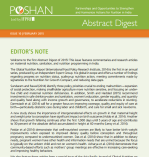 Welcome to the first Abstract Digest of 2015! This issue features commentaries and research articles on maternal nutrition, sanitation, and nutrition programming in India.
Welcome to the first Abstract Digest of 2015! This issue features commentaries and research articles on maternal nutrition, sanitation, and nutrition programming in India.
The Global Nutrition Report (International Food Policy Research Institute, 2014) is the first in an annual series, produced by an Independent Expert Group. It is global in scope and offers a number of findings regarding progress on nutrition status, scaling-up nutrition action, meeting commitments made by signatories to the Nutrition for Growth Compact, and reducing data gaps.
Sundaram and Rawal (2014) identify three policy priorities crucial to ending malnutrition – expansion of social protection, making smallholder agriculture more nutrition sensitive, and focusing on underfive child and maternal nutrition deficiencies. In addition, Smith and Haddad (2015) recommend investments in safe drinking-water and sanitation, women’s education, gender equality, and quantity and quality food along with income growth and governance, to accelerate reductions in stunting. Darmstadt et al. (2014) call for a greater focus on improving coverage, quality and equity of care at birth—particularly obstetric care during labor and childbirth, and care for small and sick newborns.
A new study shows the importance of intergenerational effects on growth in that maternal height and weight prior to conception have significant impact on birth outcomes (Addo et al. 2014). Another shows that growth faltering continues after the first 1,000 days until 5 years of age and contributes to 30 percent of the absolute deficit accumulated in height at 60 months (Leroy et al. 2014).
Potdar et al (2014) demonstrate that well-nourished women are likely to have better birth weight improvements when exposed to improved dietary quality before conception and throughout pregnancy compared to undernourished women. Das et al. (2014) show that in addition to dietary needs, pregnant women have other health and information needs that are unmet because the focus is typically on the unborn child and not on women’s health. Acharya et al. (2014) demonstrate that community-based efforts such as mothers’ group meetings are effective in increasing care-seeking and improving healthy behaviors.
We also feature three articles from a special issue of the Asia Pacific Journal of Clinical Nutrition on food and nutrition information. Antier et al (2014) assess viability of a decentralized production model for complementary foods by women’s self-help groups, Bhagwat et al (2014) examine a large-scale voluntary staple food fortification in two Indian states, and Chaturvedi et al (2014) analyze nutrition training needs of the frontline workers of the Integrated Child Development Services (ICDS) program On the sanitation front, Clasen et al. (2014) find that increasing toilet coverage alone is insufficient to reducing exposure to fecal pathogens.
Happy reading!


